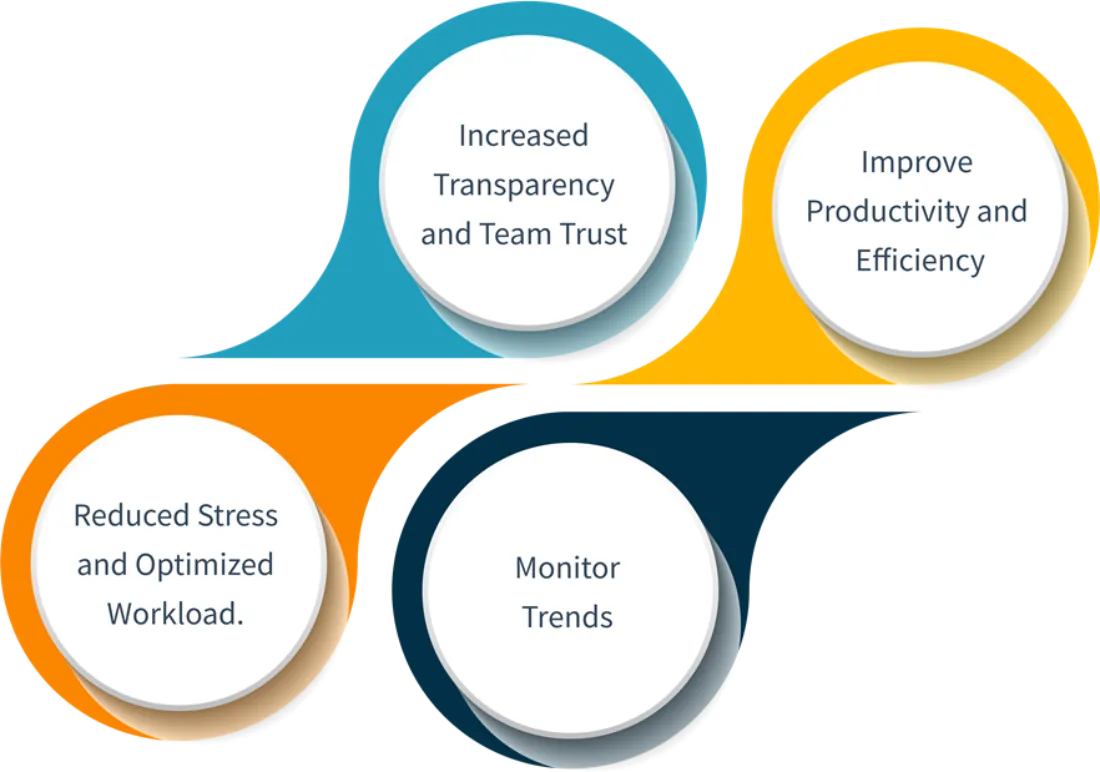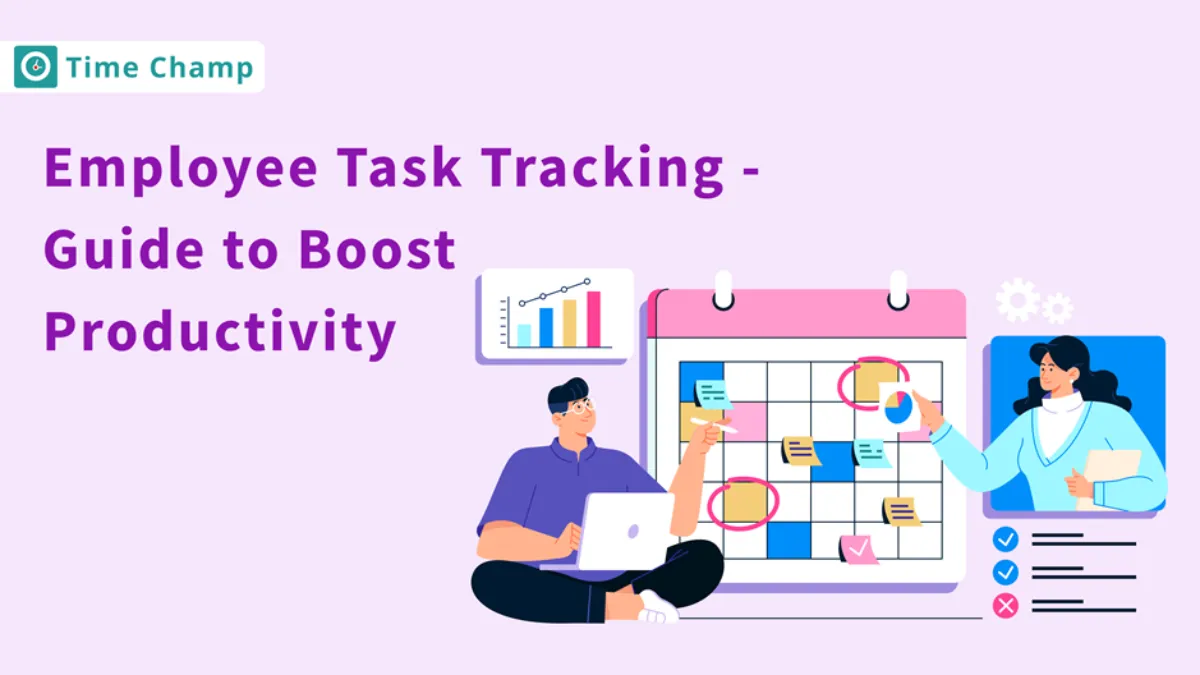Keeping track of individual employees' tasks, projects, deadlines, and resources can be difficult. Rather than struggling with the numerous emails, calendar invites, and sticky notes, a good employee task tracking solution can streamline the workflow and contribute towards productivity.
No matter whether your team works remotely, in an office, or in a hybrid mode, this in-depth guide will offer you the most efficient task-tracking methods that range from basic manual tracking to those that involve powerful automated systems and tips on facilitating their work. Find out how proper task- tracking software can transform your team’s productivity and ensure that the projects flow smoothly.
Best Ways to Track Employee Tasks
There’s no one-size-fits-all solution for tracking employee activity. In-office teams may benefit from physical trackers, while remote or hybrid teams need cloud-based tools. Simple tasks can be managed using basic methods, but recurring tasks need automation features. If you are planning to grow, select a scalable system that can adapt to your changing project and workforce needs.

Manual Methods
Manual methods are simple and easy to use, making them great for quick task tracking and one-time projects. They’re mainly useful for small, in-office teams who prefer a hands-on approach.
To-Do Lists
To-do lists act as a traditional and effective technique to manage individual tasks. They can be physical (sticky notes, notebooks) or digital (software such as Google Keep or Notion). They’re quick to create and offer a satisfying way to mark tasks as done. Digital versions often sync across devices for convenience. However, to-do lists can become cluttered without prioritization and lack automation or collaboration features, making them better suited for simple, personal task tracking rather than complex team projects.
Whiteboards
Teams can track activities and project progress visually and collaboratively using whiteboards. This method is ideal for in-office environments, as it enables everyone to view real-time changes and immediately adjust plans. Whiteboards are useful for brainstorming and easy task tracking, but they lack automation and are less effective for remote teams or complex workflows.
Excel Spreadsheets
Excel spreadsheets provide an adjustable approach to listing tasks and deadlines. They can be used to structure data, make simple lists of tasks, and provide fundamental reports. Although spreadsheets are popular and easy to understand, they are bound to consume time completely if changes are to be made by hand, and they do not have real-time collaboration powers required for large teams or distant workers.
Automated Tools
Automated tools have become an essential tool for tracking employee tasks efficiently. These tools offer real-time updates, reduce errors, and support smooth collaboration.
Employee Time Tracking Tools
Employee time-tracking tools make it easy to track work hours and the progress of tasks since they automatically record active and idle time. Tools that are popular, like Time Champ, are not just limited to time logs, but they also have scheduling management, attendance, and productivity tracking features. These tools generate detailed reports for the managers to locate the working patterns and work efficiency. They are particularly helpful for freelancers, IT professionals, and remote teams, where time tracking directly impacts deliverables and billing.
Task Management Tools
Task management tools help teams to organize, prioritize and track the tasks until completion. They have features such as task assignment, deadlines, tracking the progress, and collaborations to make sure people are all on one page. The use of such tools like Time Champ, Asana, ClickUp and Trello are used to control workloads and set reminders, and nothing is missed. These tools are simply perfect for a team of whatever size in enhancing productivity and simplifying processes to complete projects in-time.
Project Management Software
A project management platform offers end-to-end solutions for organizing, executing, and tracking complex projects. These platforms provide scheduling, allocation of resources, tracking of milestones, and communication with the team, all on one platform. When it comes to monitoring timelines, budgets, and team performance, preferred alternatives for project managers are Time Champ, Monday.com, Wrike, or ClickUp. It suits well for growing teams and large-scale projects, as it helps to keep all the members on track and up to date on business goals.
GPS-Based Employee Tracking
GPS-based location tracking tools are important in tracking employees’ movements in real time, particularly for a field team, a delivery team, or workers who work from home. These tools enable you to confirm on-site attendance, optimize routes for traveling, and be accountable. Services such as Time Champ, GeoZilla, and Hubstaff provide GPS location-based tracking that increases visibility and the efficiency of operations for location-based businesses.
Helpdesk and Ticketing Software
Ticketing systems simplify task management as they will distribute employee requests, issues, and assignments into organized tickets. These tools make sure that there is no missing, and tasks are prioritized according to urgency.
Platforms such as Freshdesk, Jira, and Zoho Desk enable teams to monitor their progress, to update, and to deal with tasks in an effective manner. They are especially useful for customer help, IT departments, and operations, all of which require well-organized workflows and accountability.
How Employee Task Tracking Boosts Team Productivity
Good task tracking is not about knowing who is doing what, but a strategic tool for increasing teams’ performance, holding team members accountable for their tasks and maintaining a healthy working environment. Regardless of whether you have a team of a few employees or departments to coordinate, task monitoring can lead to quantifiable benefits in terms of increased productivity and teamwork. Here's how:

Increases Transparency and Team Trust
Everyone can easily see and understand their tasks, which helps reduce confusion and encourages everyone to be accountable. Employees are aware of the expectations, and managers can readily track the team's progress.
Improves Productivity and Efficiency
After knowing their tasks, assignments and deadlines, employees can give full attention to the work that matters most. Task tracking reduces the risk of unnecessary repetition of work and ensures the teams keep up with project goals to speed deliveries and enhance overall productivity.
Reduces Stress and Optimized Workload
A centralized system of task management minimizes the mental stress of remembering tasks and deadlines. It enables the members of the team to prioritize, plan, and prevent the burnout that usually accompanies messy workflows. A balanced task list backs up a healthier and more sustainable pace of work.
Monitor Trends
In the data, it includes reminders of significant issues for the team, such as ongoing delays or common bottlenecks. Managers can use these results to adjust work processes, move resources around and decide strategically on major actions for long-term improvement.
Tips for Effective Task Tracking
Proper task tracking strategies are significant in improving the productivity of a team and project success. Here are some key tips to optimize your task management processes:

Set Clear and Measurable Goals
Clear and measurable goals give each task a purpose and direction. When employees know precisely what is expected of them and how success will be evaluated, then they are likely to stay motivated and on track. To clarify, establish definite quantifiable goals (deadlines, production numbers, or quality standards). This improves accountability and makes it easy to track progress and detect problems early on.
Use Consistent Naming and Deadlines
Maintaining consistency in the naming of tasks and deadlines to be met removes confusion and provides clarity of tasks throughout teams. Once everyone is using the same naming pattern and sticking to well-defined deadlines, it is easier to prioritize tasks, track the process, and ensure that there are no missed deliverables. This structure simplifies collaboration and enhances efficiency.
Encourage Updates and Review Performance Regularly
Regular task updates and performance reviews keep projects and teams on track. Employees who share their progress are more motivated, as it helps find difficulties early on and increases responsibility and transparency. A periodic examination of performance data focuses on ways to improve operations and identify top-performing team members.
Avoid Micromanaging and Focus on Outcomes
Instead of closely tracking each task, empower employees by allowing them to manage their work. Concentrate on the outcome rather than how things are done. This strategy increases morale, promotes autonomy, and leads to increased production and higher-quality results.
5 Leading Employee Task Tracking Software for Efficient Work Management
Time Champ - The Best Way to Stay on Track with Every Task
Time Champ is a best employee time and productivity tracking software built for organizations that value accuracy, clarity, and efficiency in terms of productivity and task management. Unlike other tools that just track hours spent, Time Champ provides up-to-date work progress, shows where tasks are getting delayed and recommends how they can be improved. With its task and project management, it becomes easy to manage who does what, how far progress has come, and ensure teams meet their deadlines.
Key features:
- Automatic Time Tracking: Time Champ automatically logs work hours with minimal manual input, ensuring accurate and effortless timekeeping.
- Productivity Monitoring: Measure employee productivity using detailed metrics and performance scores. Understand how time is spent across tasks and apps.
- Activity Tracking: Track real-time user activity, application usage, and website visits to get a complete view of daily operations.
- Project & Task Management: Collectively distribute work, track the team’s efforts, establish deadlines and pinpoint what may be slowing work completion.
- Automated Timesheets: Generate precise timesheets automatically, reducing the burden of manual entries and simplifying payroll and reporting.
- Real-Time Insights: Use real-time data to check on teams and projects, which aids in taking quicker actions and scheduling resources wisely.
- Seamless Integrations: Using tools like Slack, Jira, and Google Workspace makes it easy for teams to work together.
Why Time Champ Stands Out Among Other Tools?
- Advanced Task Management: Time Champ is more advanced than just time trackers by allowing you to track every task each employee is working on, manage priorities and see the progress in real-time. As a result, it becomes simple to find tasks that are slowing things down, see the progress of each task and complete the project on time.
- Ideal for Hybrid Teams: Regardless of whether employees are working remotely or at workplaces, the tool shows in real time how tasks are carried out and how the team is performing, without interrupting or “spying” on them.
- Custom Analytics and Insights: With detailed, custom reports, managers can measure how much work has been finished, check on employee performance and know when tasks are completed, which helps them direct work and boost productivity.
- Privacy-First Design: In order to support employee privacy, Time Champ only uses blurred screenshots and requires permission for tracking, encouraging trust and clarity.
Best for: Suitable for any kind of organization that aims to advance with data-driven methods and efficient results.
Toggl Track
Toggl Track is perfect for freelancers, agencies, or teams that handle several tasks, since it is easy both to use and keep organized. It’s quick to monitor how much time is spent on tasks and projects, allowing you to pay attention to billing and assign roles more precisely.
Key Features:
- One-click real-time tracking and manual time logging.
- customised reporting and analytics
- Integration with more than 100 tools.
- Project Budgeting and Time Estimates
- Team timesheets and billing support
Best For: Individuals and teams looking for a simple solution for flexible time tracking.
ClickUp
With ClickUp, firms can have access to task management, collaboration tools, and ways to improve your productivity. It comes with a flexible and scalable interface that matches the needs of teams of all sizes.
Key features:
- Task lists, Kanban boards, calendars, and Gantt charts.
- Integrated time tracking and goal planning.
- Task dependencies and automations.
- Document sharing and team conversation.
- Reporting dashboards and workload views.
Best For: Teams looking for a centralized hub for project and task management that includes time-tracking ability.
Asana
Using Asana, teams can work together, review how things are progressing and finish their projects successfully and on time. Its smooth operation and user-friendly design allow people to take care of all their main tasks seamlessly.
Key features:
- Task and subtask assignments with due dates.
- Timeline and calendar views.
- Milestone tracking and goal setting.
- It’s easy to use Google Workspace, Slack and Zoom to simplify how team communicates and works together.
- Automation for routine task flows.
Best For: Mid-to-large teams managing multiple ongoing projects and collaborative workflows.
Trello
With the Kanban board approach, Trello allows users to view and organise tasks in an accessible way. It allows teams to arrange their work more effectively and see how far they've progressed.
Key Features:
- Drag-and-drop Kanban boards.
- Customizable templates for recurring workflows.
- Checklists, labels, and task assignments.
- Power-ups for time tracking and integrations.
- Automation rules with Butler.
Best For: Creative teams or small groups looking for a straightforward, visual approach to task tracking.
Conclusion
It is no longer accepted to think of task monitoring as an extra luxury. It is required by firms seeking to increase efficiency, regulate how they work, and maintain a strong position in a competitive industry. Choosing the correct solution could completely change how teams perform their work, whether they work remotely, in the office, or in a hybrid approach.
While Toggl Track, ClickUp, Asana, and Trello all have useful capabilities, Time Champ stands out by providing a complete solution for task management, real-time productivity monitoring, and actionable insights—all in one platform.
Frequently Asked Questions
Employee task tracking refers to the practice of monitoring and organizing the tasks allocated to employees. It makes sure individuals are accountable, meet deadlines, and achieve better results.
Working with tools like Time Champ, ClickUp, or Asana makes it simple to stay on top of projects, manage what needs to be done, and exchange information quickly and in one location.
Check if the tool gives you real-time updates, lets you track time, distribute tasks, produce reports, link with tools such as Slack and Jira, automate processes, and has a user-friendly design.
Task tracking allows managers to give out work evenly, ensure employees aren’t overloaded, notice any unused resources, and adjust the project team based on how well everyone is performing.
Yes, Time Champ integrates with Google Workspace, Slack, Jira and many more tools to help users work more efficiently.








